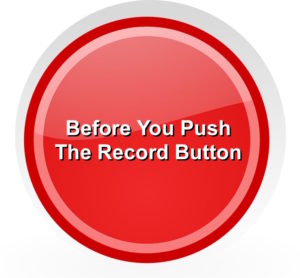- in Book Excerpt , Engineering , Production , Recording by Bobby Owsinski
- |
- 1 comments
8 Things To Check Before You Push The Record Button
 “Everything set up? Cool, let’s record. Oh, wait, it doesn’t sound like I think it should.” At this point you can continue to record and deal with the consequences later, or stop and troubleshoot, but you might be chasing your tail and it could take longer than you want to get to where you want to go. There is a better way though. Here’s an excerpt from my Recording Engineer’s Handbook 4th edition
“Everything set up? Cool, let’s record. Oh, wait, it doesn’t sound like I think it should.” At this point you can continue to record and deal with the consequences later, or stop and troubleshoot, but you might be chasing your tail and it could take longer than you want to get to where you want to go. There is a better way though. Here’s an excerpt from my Recording Engineer’s Handbook 4th edition that’s a checklist of questions to ask yourself before you ever hit the Record button.
“1. Does the instrument sound great acoustically? Make sure that you start with a great acoustic sound with the instrument well tuned and minimum of sympathetic vibrations and extraneous noises.
2. Are the mics acoustically in phase? Observe the 3:1 rule and make sure that any underneath mics are at a 90° angle to the top mics.
3. Are the mics electronically in phase? Make sure that all the mic cables are wired the same by doing a phase check.
4. Are the mics the correct distance from the instrument? If they’re too far away they’ll pick up too much of the room or other instruments. If they’re too close the sound will be unbalanced with either too much attack or ring, and not enough of the body of the instrument. Walk around the player, put your finger in your ear, and find the spot that sounds the best. Remember, most instruments need some space for the sound to develop. The ambience from the surrounding area is a big part of the sound for most instruments.
5. Does it sound the same in the control room as when you’re standing in front of the instrument? This is your reference point and what you should be trying to match. You can embellish the sound after you’ve got the sound as close to the way it was when you were standing next to the player.
6. Is there another problem besides the mic placement? A great sound is dependent upon the instrument, the player, the amp (if there is on) and the room. The player has to be able to achieve the tone you’re trying to record with his hands or mouth or voice first and foremost. The mic itself usually has less to do with the ultimate sound than the placement, room and the player and ultimately, the project itself.
You should always trust your ears and begin by listening to the musician in your studio, find a sweet spot and then begin your microphone placement there. If you don’t like the resultant sound, then move the mic or swap it with another. EQ is the last thing you should touch.
7. Is the problem in your signal chain? Don’t neglect your microphone preamp. The better your preamp, the less trouble you’ll have capturing the sound, but sometimes a certain mic/preamp combination will give you the sound you need. Don’t be afraid to experiment.
8. Is the problem in the players signal chain? A guitarist’s signal chain, for example, can be a huge help or a big hindrance. You’ll get a warmer yet aggressive guitar sound by decreasing the amount of distortion from pedals, but turning up the amp’s volume instead to obtain the sustain/distortion from the amp and speaker. Also, smaller amps and speakers tend to sound bigger than large amps/speakers when recording.
REMEMBER: Mics cannot effectively be placed by sight, which is a mistake that is all too easy to make. The best mic position cannot be predicted, it must be found.”
Ideally you want everything so sound great when you reach for the record button. Hopefully, these tips will get you there.
You can read more from The Recording Engineer’s Handbook 3rd Edition and my other books on the excerpt section of bobbyowsinski.com.

